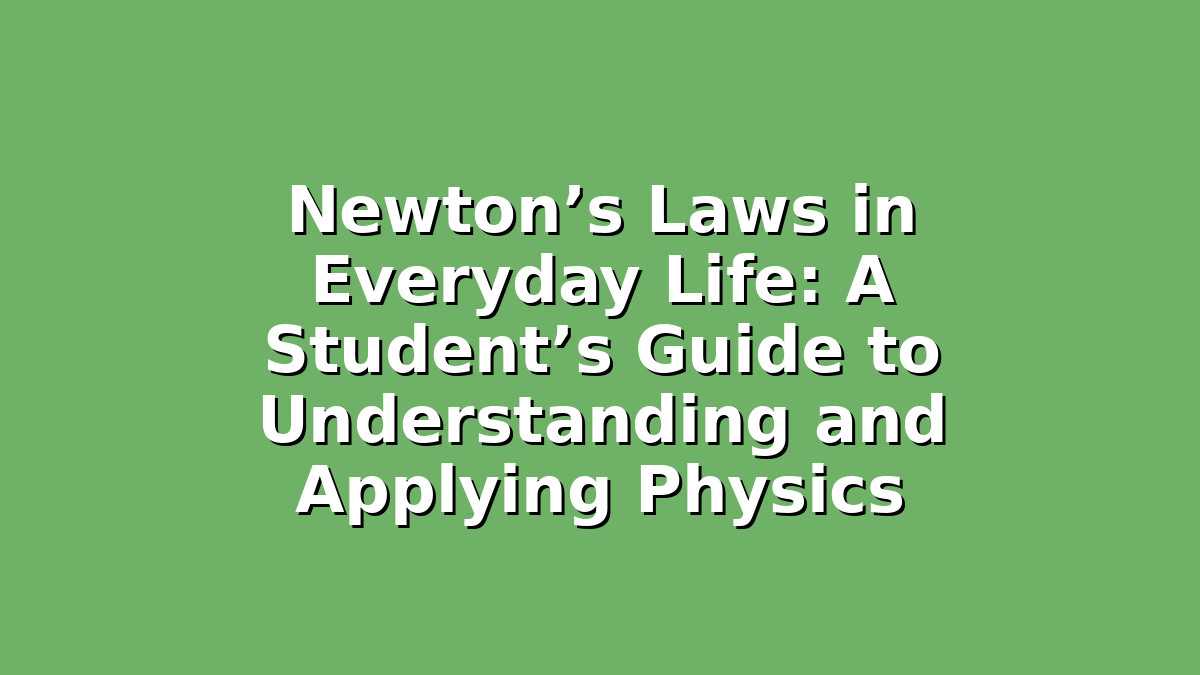When preparing for exams, especially in subjects like physics, understanding concepts deeply can make a huge difference. One of the fundamental topics that often appear in exams is Newton’s Laws of Motion. These laws, formulated by Sir Isaac Newton over 300 years ago, are not just academic theories; they explain the way objects move around us every day. As students, relating these laws to real-life situations can boost your understanding and make exam preparation more engaging and effective.
In this article, we’ll explore Newton’s three laws with practical examples from everyday life and provide study tips to help you grasp and remember these concepts better. Whether you’re revising for a physics test or just curious, this guide will encourage you to see physics not just as formulas, but as the rules governing the world around you.
—
Section 1: Newton’s First Law – The Law of Inertia and Study Focus
Newton’s First Law states that an object at rest stays at rest, and an object in motion stays in motion with the same speed and direction unless acted upon by an external force. This law is often called the Law of Inertia.
Everyday Example: Think about when you’re sitting in a car that suddenly brakes. Your body tends to lurch forward because it wants to stay in motion even though the car stops. Similarly, a book resting on your desk won’t move unless you push it.
Study Tip: Just like inertia, your brain can also resist change. It’s easy to stay “at rest” and procrastinate, but starting to study is the external force that sets you in motion. To overcome inertia:
– Break your study sessions into small, manageable chunks to make starting easier.
– Use a timer (like the Pomodoro Technique) to create a “force” that changes your mental state from rest to action.
– Remember that once you start studying, it’s easier to keep going.
By linking Newton’s First Law to your own study habits, you can understand both the physics concept and how to boost your motivation.
—
Section 2: Newton’s Second Law – Force, Mass, and Acceleration in Exam Preparation
Newton’s Second Law states that force equals mass times acceleration (F = ma). This means that the acceleration of an object depends on the force applied and its mass.
Everyday Example: Imagine pushing two shopping carts — one empty and one loaded with groceries. The empty cart (less mass) accelerates quickly with a small push (force), but the loaded cart (more mass) requires more force to move at the same speed.
Study Tip: Think of the force as your effort, the mass as the difficulty of a subject or topic, and the acceleration as your progress. Some topics might feel “heavy” and harder to “move” forward, requiring more effort. To apply this law to studying:
– Identify topics that are challenging (high “mass”) and allocate more focused effort (“force”) on them.
– Don’t spread your energy too thin. Concentrated effort on difficult areas accelerates your progress.
– Use active study techniques like solving practice problems and teaching concepts to others to increase “force” effectively.
Understanding that your effort must increase with difficulty can help you plan study sessions that maximize progress and help you feel less overwhelmed.
—
Section 3: Newton’s Third Law – Action and Reaction in Study Environment and Collaboration
Newton’s Third Law states that for every action, there is an equal and opposite reaction. This law explains interactions between objects.
Everyday Example: When you jump off a boat onto a dock, the boat pushes back and moves away. Similarly, when you push a wall, the wall pushes back against your hand with equal force.
Study Tip: This law applies beautifully to your study environment and collaboration:
– Action: The effort you put into studying or asking questions.
– Reaction: The feedback or improvement you gain from your environment or peers.
To harness this law:
– Engage actively in study groups. When you ask questions or explain concepts, your peers respond, and you gain deeper understanding.
– Create a positive study environment. For example, if you keep your study space organized and free from distractions, your focus “pushes back” by improving.
– Practice reciprocity. Helping classmates with their doubts encourages them to help you in return, creating a productive “reaction” in your learning community.
By seeing study as an interaction, not a solo activity, you can boost motivation and deepen your understanding.
—
Conclusion
Newton’s Laws are more than just textbook formulas — they describe the physics of the world you live in and can inspire practical approaches to your study habits. By connecting Newton’s First Law to overcoming procrastination, the Second Law to managing study effort, and the Third Law to collaborative learning, you gain a clearer and more memorable understanding of physics concepts and effective study strategies.
Remember, exams are about applying knowledge, not just memorizing it. Try to observe these laws in your daily life and use them as metaphors for your study routine. Keep pushing forward, stay curious, and enjoy the process of learning — just like objects in motion, momentum builds once you get started!
Good luck with your exams, and remember: with the right force and direction, you can accelerate your success!
—

Responses